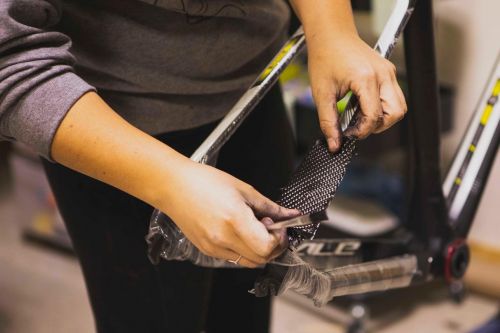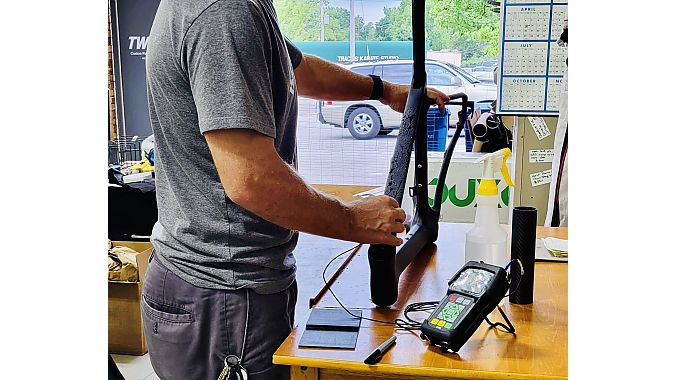A version of this article ran in the October issue of Bicycle Retailer & Industry News.
By Dan Roe
KIRKWOOD, Mo. (BRAIN) — Since he began offering ultrasonic carbon fiber inspections in June, St. Louis-area carbon repair and paint shop owner Nick Hand has found manufacturing defects in two bikes that showed no signs of damage. Once, a company allowed resin to dry up during the manufacturing process, resulting in "dry carbon" with no structural integrity. On another bike, a manufacturer didn't remove the plastic backing from a layer of pre-impregnated carbon, resulting in a tube that was half as thick as it should have been.
But most of Hand's customers at TW Carbon come in with obviously cracked frames and wheels, thanks to an informal referral program from the area's crash-prone criterium scene. The steady stream of ultrasonic carbon fiber inspections means Hand's new equipment is paying for itself.
"I've had customers ask for this service in the past, and I knew that this was something that could really bring a lot of closure to people," Hand said. "It helps them feel safer about the bike they're riding and the repairs we're doing."
TW Carbon is one of three carbon repair shops in the world using Cycle Inspect, a new product suite that Australian cyclist and entrepreneur Michael Briggs hopes will revolutionize the way people buy, sell and maintain carbon fiber bikes and components by offering bike shops and carbon repairers a low-cost entry to high-tech testing.
For about $7,000 — either up-front or through a 24-month lease-to-own program — Cycle Inspect provides ultrasonic equipment, a virtual training program, and software that uses data from thousands of scans to inform users' damage assessments.
Presently, Hand and Briggs said most bike shops and carbon repair specialists use the "tap" method of detecting fractures in carbon fiber: Tap a coin against the material until it makes a different sound and there's your crack. However, while the tap method can identify a fracture, it can't indicate the type or severity of a fracture, or predict how it may spread across the bike.
Instead, Cycle Inspect uses an Olympus ultrasonic thickness gauge with a pinky nail-sized scanning diode to more precisely identify and map internal delaminations. That alone isn't a novel idea — Ruckus Composites of Portland, Oregon, has been using the technology since 2016. But Hand said a lack of available training and the high cost of the equipment kept him and other carbon repairers from adopting the technology.
Briggs encountered a similar problem when his father was buying a used carbon fiber road bike. Unable to find nearby carbon repair specialists in Tasmania, Briggs' father stripped and shipped the frame to a specialist who ultimately determined that it was full of delaminations and cracks, relegating it to trainer duty.
"That personal experience got me interested in the problem," Briggs said. "If you can't see damage and get a visual idea of the extent of underlying damage through impact, misuse, or manufacturing, then how do people in my father's situation, who are new to the sport, get a certain degree of confidence?"
Briggs' background is in corporate marketing, but the Cycle Inspect team includes an aerospace engineer with 30 years of experience. Briggs' team consulted with carbon fiber researchers at Deakin University in Victoria, Australia, to benchmark nondestructive testing methods, ultimately settling on ultrasound over x-rays and thermography.
Having settled on the ultrasonic equipment, Briggs began working on a standardized training program to teach shop technicians to identify damage. It includes dummy carbon tubes with identical flaws, which help trainees learn to locate inconsistencies and calibrate their equipment. Hand, who had taken one class on the ultrasonic devices previously, said he completed the training in a few weeks' time.
The software guides users' decisions with an algorithm developed from research data and interviews with carbon fiber engineers and designers. "The algorithm is a companion to practitioners, ensuring they're following the correct processes and providing recommendations and assessments of risk so they are empowered to make more consistent and more objective interpretations of risk," Briggs said.
The Olympus device, training program and software suite cost $10,000 AUD (about $7,000). Cycle Inspect also charges a monthly fee of roughly $70 to license its software, which evolves as the company takes in more testing data, Briggs said. To ease the cost burden, Cycle Inspect offers a lease-to-own program where shops pay about $300 monthly until they own the product in 24 months. Shops can also demo the training and software before committing to the purchase.
At TW Carbon, Hand charges $75 to inspect individual tube shapes. Wheels are $100 each and entire frames are $300, which take Hand two to three hours to scan. "I've been very happy with the amount of business we've got from it so far," he said. "It's easily paid for itself and brought in a little extra on top."
Briggs and Hand laid out myriad use cases for in-house carbon testing at bike shops and carbon repair companies. People buying and selling pre-owned bikes can obtain certificates of inspection to prove their structural integrity. Carbon repairers may receive more information about damaged frames and components for better results. In the case of Hand's customers with defective frames, the inspection could be used to justify a repair or replacement under warranty. Riders who insure their bikes could also use inspection results to justify claims. "We're basically offering the Carfax for bikes," Hand said.
Hand also sees customers who want their visually undamaged gear inspected because they think it may be compromised, whether from a crash or a previous owner. While Hand said random failures of carbon bikes and components are exceedingly rare, many customers without obviously broken equipment are still willing to pay for peace of mind.
"The industry has done a wonderful job of scaring people about carbon fiber, creating this image that it's a super material that only they have answers to, and it has to be cared for with kid gloves," Hand said. "Carbon fiber is literally the most repairable material there is. The only thing keeping someone from repairing a bike is how much money they want to spend."




